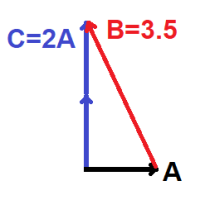EulersNumber
New member
- Joined
- Jul 18, 2024
- Messages
- 3
Hello,
I'm stuck on a word problem that states:
A vector B with a magnitude of 3.5 meters is added to vector A, which lies along the x-axis. The sum of these two vectors is a third vector that lies along the y-axis and has a magnitude twice the magnitude of vector A. What is the magnitude of vector A?
I've no idea what is meant by "lies along the x/y axis". It almost sounds like a unit vector or a vector (working with 2D Cartesian vectors in physics class for context) that is parallel to the x axis and another parallel to the y axis. This would be easier to solve as that would make vector B the hypotenuse of a right angle triangle. Except for other exercises where this hasn't apparently been the case. Am I overthinking it? What could they mean?
I'm stuck on a word problem that states:
A vector B with a magnitude of 3.5 meters is added to vector A, which lies along the x-axis. The sum of these two vectors is a third vector that lies along the y-axis and has a magnitude twice the magnitude of vector A. What is the magnitude of vector A?
I've no idea what is meant by "lies along the x/y axis". It almost sounds like a unit vector or a vector (working with 2D Cartesian vectors in physics class for context) that is parallel to the x axis and another parallel to the y axis. This would be easier to solve as that would make vector B the hypotenuse of a right angle triangle. Except for other exercises where this hasn't apparently been the case. Am I overthinking it? What could they mean?

